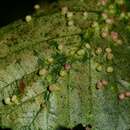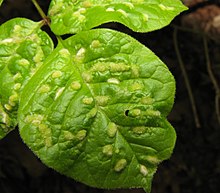en
names in breadcrumbs


Eriophyid mites, which are found around the world, are translucent white, cigar-shaped microscopic mites that are noticed when their feeding causes galls or other abnormalities of plant tissues. They are invisible to the unaided eyemeasuring just a few hundredths of centimeters in length. Unlike most mites, eriophyids only have 4 legs located near the head. Some species are host-specific, while others attack a wide range of plant species.
Eriophyids generally overwinter as fertilized adult females under bud scales or in protected sites on or near the host plant. They emerge to lay eggs and feed on new foliage when buds begin to break in the spring. Both males and females are present throughout the growing season. Reproduction is continuous, with a generation typically completed every 2 to 3 weeks; overlapping generations are present.
Some eriophyids may transmit viruses that can deform plants or cause economic losses to various crops.
(Davis 2011)



Eriophyidae is a family of more than 200 genera of mites, which live as plant parasites, commonly causing galls or other damage to the plant tissues and hence known as gall mites. About 3,600 species have been described, but this is probably less than 10% of the actual number existing in this poorly researched family. They are microscopic mites and are yellow to pinkish white to purplish in color. The mites are worm like, and have only two pairs of legs. Their primary method of population spread is by wind. They affect a wide range of plants, and several are major pest species causing substantial economic damage to crops. Some species, however, are used as biological agents to control weeds and invasive plant species.

Notable species in this family include:
 Rust mite, Aceria anthocoptes
Rust mite, Aceria anthocoptes  Eriophyes cerasicrumena, galls on cherry
Eriophyes cerasicrumena, galls on cherry  Aceria fraxini, galls
Aceria fraxini, galls Eriophyidae is a family of more than 200 genera of mites, which live as plant parasites, commonly causing galls or other damage to the plant tissues and hence known as gall mites. About 3,600 species have been described, but this is probably less than 10% of the actual number existing in this poorly researched family. They are microscopic mites and are yellow to pinkish white to purplish in color. The mites are worm like, and have only two pairs of legs. Their primary method of population spread is by wind. They affect a wide range of plants, and several are major pest species causing substantial economic damage to crops. Some species, however, are used as biological agents to control weeds and invasive plant species.
 Aculops rhois, galls on poison ivy
Aculops rhois, galls on poison ivy